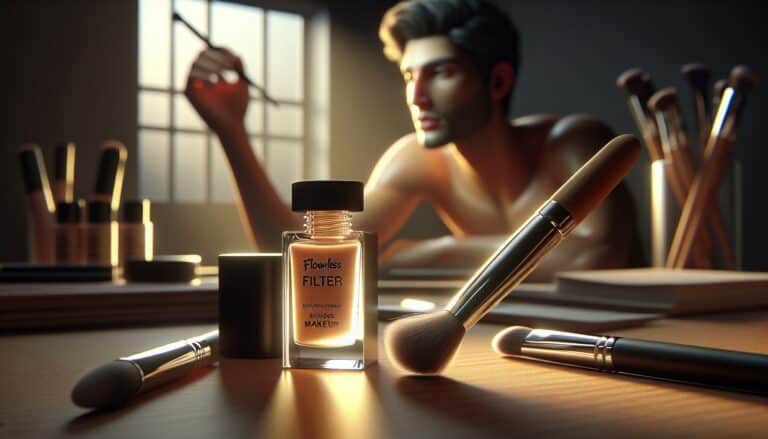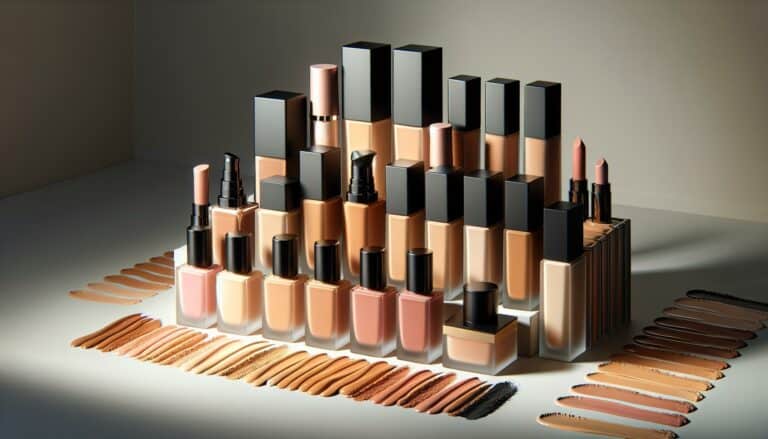DIY Foundation Guide: Match Your Skin Tone Perfectly
Why Make Your Own Foundation
In the quest for the perfect makeup, finding a foundation that matches your skin tone and type can feel like searching for a needle in a haystack. But what if you could create the perfect match right in your own home? Customization is the key advantage of making your own foundation. You’re not just limited to the shades available on the market; you can blend the perfect hue that complements your skin perfectly.
Personalization at Its Best
When you decide to go the DIY route, you take control over the ingredients, which means you can avoid harsh chemicals and preservatives that are often found in commercial foundations. This is particularly beneficial for those with sensitive skin or specific skin concerns. By selecting natural and nourishing ingredients, you can create a foundation that not only looks good but is also good for your skin.
“Making your own foundation means you’re in control of what you put on your skin. It’s empowering and healthy.”
The Cost-Effectiveness of DIY Foundation
Let’s talk numbers. Making your own foundation can also be incredibly cost-effective. Below is a simple comparison:
| Ingredient | Cost per Unit | Quantity Needed | Total Cost |
|---|---|---|---|
| Base ingredient (e.g., sheer butter) | $5 | 1 oz | $5 |
| Color pigments | $3 | 0.1 oz | $0.30 |
| Additional ingredients (e.g., oil, sunscreen) | $2 | 0.5 oz | $1 |
Total DIY Foundation Cost: $6.30
Contrast this with the average cost of high-end foundations, which can easily exceed $40, and the savings become undeniable. However, it’s not just about saving money; it’s about investing in your skin’s health and having the freedom to experiment with colors and textures. You might start with foundation, but soon you could be crafting your entire makeup line, tailored exclusively to your preferences and needs.
Understanding Your Skin Type and Tone

Before diving into the process of making your own foundation, it’s crucial to understand your skin type and tone. This knowledge will guide you in selecting the right ingredients that will not only match your skin color but also cater to its specific needs.
Your skin type can be broadly categorized into four groups:
- Oily
- Dry
- Combination
- Sensitive
Each type requires different care, thus affecting the choice of ingredients for your foundation. For example, if you have oily skin, you might want to opt for ingredients that offer a matte finish.
When it comes to skin tone, you’re aiming to match the foundation perfectly with your natural skin color. A simple way to determine your skin tone is the wrist test. Look at the veins on the inside of your wrist. If they appear blue or purple, you likely have a cool undertone. If they look green, you have a warm undertone.
“Knowing your skin tone isn’t just about getting a foundation that matches. It’s about enhancing your natural beauty and ensuring your skin looks its best.”
To further help you identify your skin type and tone, refer to the following table:
| Skin Type | Characteristics | Skin Tone | Undertone Test Result |
|---|---|---|---|
| Oily | Shiny appearance, prone to breakouts | Warm | Green veins |
| Dry | Rough and dull appearance, may flake | Cool | Blue/Purple veins |
| Combination | Dry in some areas, oily in others | Neutral | Mixture of both |
| Sensitive | Reacts easily to certain products and environments | Varies | Depends on individual |
By tailoring your foundation formula to both your skin type and tone, you’ll not only sport a flawless look but also nurture your skin in the most effective way. Bear in mind, perfection in DIY foundation doesn’t occur overnight. Experimentation and patience are your best allies in achieving the ultimate match.
Choosing the Right Ingredients
After understanding your skin type and tone, selecting the right ingredients is your next pivotal step in making your own foundation. Remember, the quality and compatibility of the ingredients with your skin can make or break your DIY foundation.
Different bases will cater to different needs. For instance, mica powder works well for a glowing finish, while zinc oxide offers excellent coverage and sun protection. In addition to these, you’ll need to choose carrier oils and colorants that match your skin type and tone.
Carrier Oils
Your choice of carrier oil is crucial because it will affect the foundation’s feel, finish, and nourishment level. Here’s a quick guide:
| Skin Type | Recommended Carrier Oils |
|---|---|
| Oily | Jojoba, Argan |
| Dry | Coconut, Avocado |
| Combination | Sweet Almond, Grape Seed |
| Sensitive | Sunflower, Rosehip |
Colorants
For colorants, titanium dioxide and iron oxides are your go-to choices. They provide the pigmentation and coverage needed. Always start with small amounts and gradually build up to get your perfect shade.
Remember: “The best foundation is the one that disappears on your skin. Achieving that requires not just the right shade, but the right ingredients that enhance your skin’s natural beauty.”
Finally, consider adding a natural preservative like vitamin E to extend your DIY foundation’s shelf life. With these ingredients at hand, you’re now ready to embark on the mixing phase, optimizing the formulation for your unique skin profile.
Tools and Equipment Needed
When diving into the world of DIY makeup, having the right tools and equipment is just as crucial as the ingredients themselves. To start your journey toward crafting the perfect foundation tailored to your skin, you’ll need several key items that ensure a smooth, well-blended, and hygienic production process.
- Digital Scale: Precision is key when measuring ingredients, making a digital scale an indispensable tool in your DIY makeup kit.
- Mini Mixer or Coffee Grinder: Achieving a uniform texture and color blend in your foundation requires a good mixing tool. A mini mixer or a clean coffee grinder can do the job efficiently.
- Spatulas and Mixing Bowls: Non-metal spatulas and glass or plastic mixing bowls are essential for mixing your ingredients without any chemical reaction.
- Ph Strips: Ensuring the correct pH level of your foundation is important for skin compatibility.
Here’s a quick reference table highlighting why each tool is vital:
| Tool | Importance |
|---|---|
| Digital Scale | Ensures precise ingredient measurement |
| Mini Mixer/Grinder | Creates a smooth, even mixture |
| Spatulas | For hygienic mixing |
| Mixing Bowls | Non-reactive surface for mixing |
| Ph Strips | Verifies skin-friendly pH level |
Remember, cleanliness is next to godliness in DIY cosmetics. Before you begin, ensure all your tools and equipment are sanitized to prevent any form of contamination.
“The right tools in your DIY beauty arsenal can transform your home into a professional makeup lab.”
Taking the time to gather these tools before you start will not only make the process more enjoyable but will also contribute to the quality of your final product. Your skin will thank you for the extra effort in personalizing your makeup to fit its needs perfectly.
Step-by-Step Guide to Making Foundation
After ensuring you’ve got all the right tools and your workspace is sanitized, it’s time to dive into the actual process of making your foundation. Remember, precision and patience are your best friends here.
- Start with Base: Your foundation base will be a mixture of sericite mica and zinc oxide. This provides the silky texture and offers sun protection respectively.
- Pigment Mixing: This step involves careful addition and blending of titanium dioxide, iron oxides, and ultramarine blue to match your skin tone perfectly. You’ll need to experiment with tiny amounts until you hit the right color.
- Combine and Grind: Once you’ve got your pigments and base ready, combine them thoroughly in your mixing bowl. Use your mini mixer or coffee grinder at this stage to ensure a fine, homogenous blend.
- Add Binders: To give your foundation staying power, incorporate a small amount of jojoba oil or dimethicone. These binders help the foundation adhere to your skin smoothly.
- Adjust and Test: Here’s where you adjust the color and test the pH using strips. It’s crucial that the foundation matches your skin not only in color but also in acidity to prevent irritation.
Here’s a basic ratio to start with, but remember, adjust according to your needs and color:
| Ingredient | Ratio |
|---|---|
| Sericite Mica | 2 parts |
| Zinc Oxide | 1 part |
| Titanium Dioxide | 0.5 parts |
| Iron Oxides | 0.25 parts |
| Ultramarine Blue | Tiny pinch |
| Binder | To preference |
“Perfection is achieved not when there is nothing more to add, but when there is nothing left to take away.” – This principle applies brilliantly to making your foundation. Start simple and build from there.
And that’s it! Let your creation set, do a final skin test, and you’ll have created something truly unique and tailored just for you. Stay tuned for ways to further customize and enhance your foundation.
Tips for Customizing Your Formula
When diving into the world of DIY foundation, customization is where the real magic happens. Beyond the base ingredients, fine-tuning your formula to perfectly match your skin’s needs and preferences is key. Here are some pointers to keep in mind:
- Understand Your Skin Type: Your skin type—be it oily, dry, or combination—plays a crucial role in how your foundation interacts with your skin. For oily skin, consider adding more zinc oxide for its mattifying properties. Dry skin benefits from increased levels of jojoba oil or other hydrating binders.
- Experiment with Color Adjustments: Getting the right shade requires patience and precision. Start with the basic ratios and adjust slowly. Here’s a simple starter chart:
| Ingredient | Purpose | Starting Ratio |
|--------------------|----------------------|----------------|
| Sericite Mica | Base | 60% |
| Zinc Oxide | Coverage & SPF | 20% |
| Titanium Dioxide | Lightening | 5-10% |
| Iron Oxides | Color Matching | Varies |
| Ultramarine Blue | Cool Tone Adjusting | Trace Amounts |
- Add Luxurious Touches: For a feeling of luxury, include ingredients like silk powder for a smooth finish or mica for a subtle glow. Remember, less is more—start with small amounts to prevent overwhelming your base.
“Customization is about creating something uniquely yours. Don’t be afraid to experiment, but always remember to document your changes for consistency.“
By focusing on these key areas, you’ll not only craft a foundation that looks great but also feels amazing on your skin. Whether it’s adjusting the coverage, finish, or even the skincare benefits, the power of customization lies in your hands. Go ahead, start mixing, and see where your creativity takes you.
Storing and Using Your DIY Foundation
Once you’ve perfected your foundation mix, knowing how to store and use it effectively ensures it stays fresh and performs well. Containers are key. Opt for airtight, opaque jars to shield your product from air and light, both of which can degrade the ingredients. Glass containers are a fantastic choice as they don’t react with the formulation and are easily sterilized.
Here’s a quick view of container options:
| Container Type | Pros | Cons |
|---|---|---|
| Glass Jars | Non-reactive, Sterilizable | Breakable |
| Plastic Jars | Lightweight, Less Breakable | May React with Formula |
| Metal Tins | Durable, Blocks Light | Possible Corrosion |
Application is just as crucial as storage. Always use clean tools to avoid contaminating your foundation. Whether it’s a sponge, a brush, or your fingers, ensuring they’re sanitized keeps your skin clear and your foundation pure.
Pro Tip: “Less is more. Start with a small amount and build up coverage gradually. This way, you achieve a more natural look and waste less product.”
Adding a binding ingredient like jojoba oil not only improves application but also extends the life of your foundation by keeping the mixture cohesive. Remember, the right texture makes application smoother and coverage more even.
Experimentation doesn’t stop once you’ve created your foundation. As you use it, you might find the need to adjust its thickness, coverage, or even color. Keeping notes on your formula adjustments will help you replicate or tweak the recipe in future batches. Documenting changes is as important as the creation process itself. This ongoing adventure in customization is what makes DIY foundation so rewarding.
Pros and Cons of Homemade Foundation
Embarking on the journey of making your own foundation comes with its set of rewards and challenges. Understanding these can help you gauge whether it’s the right path for you.
Pros:
- Customization: One of the most significant advantages is the ability to customize your foundation to match your skin tone perfectly. By adjusting the pigments, you can create a shade that’s a perfect match for your skin.
- Natural Ingredients: You know exactly what’s going into your foundation, allowing you to choose natural and non-irritating ingredients. This is especially beneficial if you have sensitive skin.
- Cost-Effective: Once you have the base ingredients, making your foundation can be more cost-effective than purchasing high-end brands.
"Creating your own foundation allows you to have complete control over the ingredients, ensuring a perfect match and healthier skin."
Cons:
- Time-Consuming: Finding the perfect formula requires patience and time. The initial trial and error phase can be particularly lengthy.
- Shelf Life: Homemade cosmetics don’t contain the preservatives found in commercial products, resulting in a shorter shelf life.
- Consistency: Achieving a consistent texture and coverage can be challenging. It may take several attempts to get it right.
| Pros | Cons |
|---|---|
| Customization | Time-Consuming |
| Natural Ingredients | Short Shelf Life |
| Cost-Effective | Inconsistent Texture |
Understanding these aspects, you can better prepare for the adventure of crafting your foundation. Remember, each step of the process helps you learn more about what works best for your skin, making it a rewarding experience.
Conclusion
Embarking on the journey of crafting your own foundation is both exciting and rewarding. You’ve learned the importance of choosing the right ingredients, matching the pigment to your skin tone, and customizing the formula to meet your skin’s needs. Let’s not forget the value of precision and patience you’ve honed throughout this process.
Developing the perfect foundation is an art. Remember, trial and error are part of the adventure. Your first batch might not be perfect, but each attempt brings you closer to creating your ideal foundation.
Consider the following table that outlines the pros and cons of homemade foundation. This will help you keep perspective on what to expect:
| Pros | Cons |
|---|---|
| Customization | Time-consuming trial and error |
| Natural ingredients | Shorter shelf life |
| Cost-effectiveness | Achieving consistent texture and coverage |
“The beauty of homemade foundation is not just in the product, but in the process of understanding and catering to your unique skin.”
By now, you’ve seen the flexibility and creativity that comes with making your own foundation. Whether you’re seeking a more natural option, trying to save money, or simply enjoy DIY beauty projects, this experience has likely enriched your understanding of cosmetic science and skincare.
As you continue to refine your formula and experiment with different pigments and ingredients, keep in mind the power of customization. This is your chance to create something that perfectly caters to your skin’s needs and preferences.








